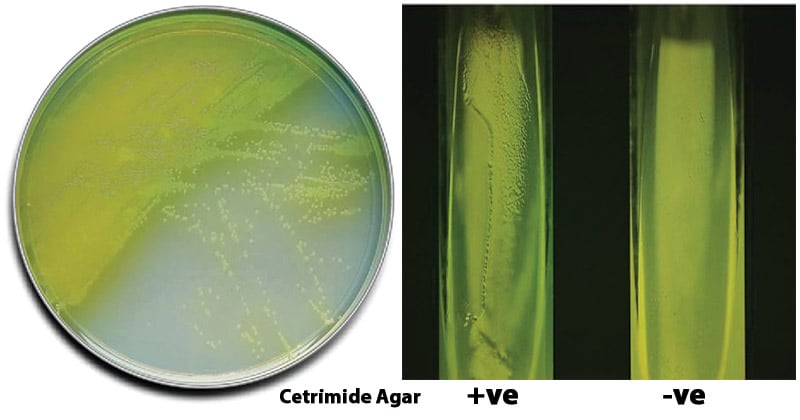Interesting Science Videos
What is a Cetrimide Agar?
Cetrimide is a quaternary ammonium salt, which acts as a cationic detergent that reduces surface tension in the point of contact and has precipitant, complexing and denaturing effects on bacterial membrane proteins. It exhibits inhibitory actions on a wide variety of microorganisms including Pseudomonas species other than Pseudomonas aeruginosa. Cetrimide agar was first developed by Lowburry and is a modification of Tech Agar (developed by King et al.) with the addition of 0.1% cetrimide (cetyl trimethyl ammonium bromide) for the selective inhibition of organisms other than Pseudomonas aeruginosa. Cetrimide agar is primarily used for selective isolation and presumptive identification of Pseudomonas aeruginosa from clinical and nonclinical specimens.
Composition of Cetrimide Agar
| Ingredients | Grams/liter |
| Gelatin peptone | 20.0gm |
| Magnesium chloride | 1.4gm |
| Potassium sulfate | 10.0gm |
| Cetrimide | 0.3gm |
| Glycerol | 10.0ml |
| Agar | 13.6gm |
Final pH (at 25°C) 7.2±0.2
Principle of Cetrimide Agar
Cetrimide agar is used to determine the ability of an organism to grow in the presence of cetrimide, a toxic substance that inhibits the growth of many bacteria by causing the release of nitrogen and phosphorous, which slows or kills the organisms because organisms other than P. aeruginosa are unable to withstand this germicidal activity, while P. aeruginosa is resistant to cetrimide. Hence, it is used as a selective medium for the isolation of Pseudomonas aeruginosa from various clinical specimens. Pseudomonas aeruginosa can be identified due to their characteristic production of pyocyanin, a blue, water-soluble, non-fluorescent phenazine pigment coupled with their colonial morphology and the characteristic grape-like odor of aminoacetophenone. P. aeruginosa is the only species of Pseudomonas or gram-negative rod known to excrete pyocyanin.
Cetrimide is a quaternary ammonium salt, which acts as a cationic detergent when comes in contact with the bacterial cells, causing the release of nitrogen and phosphorous which in turn has denaturing effects on membrane proteins of the bacterial cell. Pseudomonas aeruginosa produces a number of water-soluble pigments, including the yellow-green or yellow-brown fluorescent pigment pyoverdin (fluorescein). When pyoverdin combines with the blue water-soluble pigment pyocyanin, the bright green color characteristic of Pseudomonas aeruginosa is created. Cetrimide enhances the production of both pyocyanin and fluorescein pigment. Gelatin peptone provides necessary nutrients for P. aeruginosa. Sodium chloride maintains osmotic equilibrium in the medium. Magnesium chloride and potassium sulfate stimulate pyocyanin production, which is a blue-green pigment, diffusing into the medium. Glycerol acts as the carbon source. Agar is the solidifying agent.
Preparation of Cetrimide Agar
- Add 45.3 gm of the medium in 1 litre of distilled water.
- Add 10ml of glycerol and boil to dissolve completely.
- Sterilize by autoclaving at 121°C for 15 minutes.
- Cool the medium to approximately 50°C and pour into sterile Petri dishes.
Result Interpretation of Cetrimide Agar

| Results | Observations |
| Positive | Pigmented blue, blue-green colonies. Colonies exhibiting fluorescence at 250nm and a blue-green pigmentation are considered as presumptive positive. |
| Negative | No growth |
Uses of Cetrimide Agar
- It is primarily used for the selective isolation and presumptive identification of Pseudomonas aeruginosa from clinical and nonclinical specimens.
- It is also used for determining the ability of an organism to produce fluorescein and pyocyanin.
- It is used to isolate and purify Pseudomonas aeruginosa from contaminated specimens.
Limitations of Cetrimide Agar
- This medium is a selective medium; some strains may show poor growth as cetrimide is highly toxic.
- Occasionally some enterics will exhibit a slight yellowing of the medium; however, this coloration is easily distinguished from fluorescein production because this yellowing does not fluoresce.
- Some non-fermenters and some aerobic spores formers may exhibit a water-soluble tan to brown pigmentation on this medium. Serratia strains may exhibit a pink pigmentation.
- Studies of Lowbury and Collins showed P. aeruginosa can lose its fluorescence under UV if the cultures are left at room temperature for a short time. Fluorescence reappears when plates are re-incubated.
- Additional testing such as biochemical tests and serological procedures should be performed to confirm the findings and to confirm a diagnosis of P. aeruginosa
References
- Tille P.M (2014)Bailey and Scott’s diagnostic microbiology, Thirteen edition, Mosby, Inc., an affiliate of Elsevier Inc., 3251 Riverport Lane, St. Louis, Missouri 63043
- http://himedialabs.com/TD/M024.pdf
- http://himedialabs.com/TD/M024B.pdf
- https://microbeonline.com/cetrimide-agar-composition-principle-preparation-uses/
- https://catalog.hardydiagnostics.com/cp_prod/Content/hugo/CetrimideSelAgar.htm
